#scientific instrument
Explore tagged Tumblr posts
Text
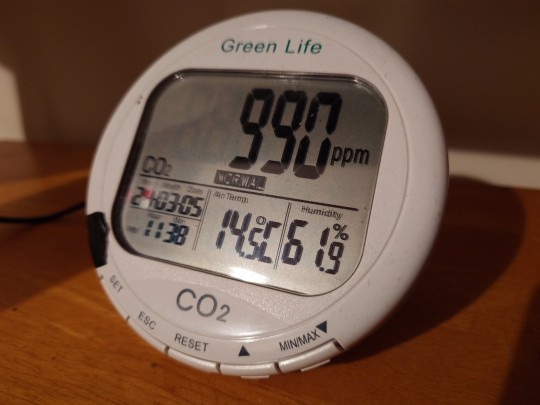
I really like my CO2 meter and I want to tell you about it!
It's a little gadget that measures the amount of carbon dioxide in the air. Did you know your body at rest burns about 100 grams of food/fat an hour? This means you're constantly breathing out carbon dioxide at a rate of about 100 grams an hour. This can rise by quite a lot of you're exercising, and it's less when you're sleeping. This means if you usually keep your doors and windows closed, as I usually do in winter since I live in a cold climate, it can build up fast. You can even breathe directly on the meter and watch the number rise rapidly.
I've had this meter on my desk for many years. It's basically a clock so you can notice the air quality at a glance and it's always on and doesn't produce light. (Note the black tape over the power LED on the left because my autistic ass can NOT sleep with an LED in the room.) It cost about £90 when it was new so it's not the cheapest thing in the world but it's built to last and it's been worth it. This isn't an ad and I'm not saying go for this brand, it's just a gadget that I think improves my life. It's always a good reminder of when I should open the windows.
I'm not 100% sure how well supported this is, but I've seen it said online that a carbon dioxide level of over 1000ppm can lower a person's cognitive function by about 25%. It can be an issue with classrooms with a lot of people. Normal outdoor levels are about 300-400ppm. Whether you believe that is up to you, but I do think fresh air makes people feel better and this serves as a good reminder to let it in. People like to make carbon monoxide jokes on this website, but sometimes high CO2 can be an issue around his you generally feel. It can also build up faster than you'd think if you have multiple people about and no windows open.

Time to open the window! (Apologies for the photo quality, the reflective LCD is not the easiest thing in the world to photograph without shadows or huge reflections.)
462 notes
·
View notes
Text
Microbial Air Sampler
A microbial air sampler is a specialized device used to monitor and sample the microbial content present in the air. It plays a crucial role in various industries such as pharmaceuticals, healthcare, food processing, and environmental monitoring where maintaining air quality is essential for more visit labnics.com.

0 notes
Text
Auto Chemistry Analyzer
Auto Chemistry Analyzer is a benchtop analyzer that can perform 400 tests per hour. With expanded on-board testing, reduced sample volume, and simple operation, this is a perfect chemical analyzer for low to mid-volume hospitals and laboratories around the world. The convenient interface provides a long-term basis for analytical expertise. This system contains standard test menus, assay methods, instrument operations, and reference ranges, all of which limit operator variation and offer consistent quality results.
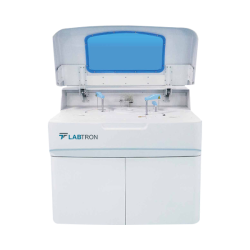
The Auto Chemistry Analyzer is a cutting-edge laboratory instrument designed to streamline and automate the analysis of various chemical components within biological samples. This advanced technology revolutionizes the field of clinical diagnostics by providing accurate and rapid results for a wide range of biochemical tests.
0 notes
Text
-86 °C Ultra Low Temperature Chest Freezer
-86 °C Ultra Low Temperature Chest Freezer Cabinet Type=chest; Capacity=458-l; Temperature Range=40-deg-c-to-86-deg-c; Cooling Performance=86-deg-c; Cooling Method=direct-cooling; Shop online at Labtron.cc.

0 notes
Text

#ancient scientific instruments#astrolabe#astronomy#astrology#astronomical#instruments#science#armillary sphere#steampunk#art#aesthetic#digital art#vintage#artwork#mountains#stars#planets#moon#gif#beauty-funny-trippy
270 notes
·
View notes
Text
i think i've read somewhere that intelligent people are freakier...in bed...... (this might be right or/and wrong. i don't think i've ever come across a scientific study of this particular claim. therefore, please take this with heaping spoonfuls of salt.)
......but i kept thinking of jiang tian and sheng wang in the novel and wow. i think it's somewhat true.
#i'm going through their story again and Lord...#the amount of want and urge and desire and passion they have for each other is just so overpowering#they just naturally gravitate towards each other and i find it quite... cute?#but i can't help but scream whenever they get a //bit// freaky#if season 2 ever happens... i would like to see some of these scenes coming to life#i think it would be fun to see jiang tian being a bit out of place and sheng wang being the reason behind it#especially things that happen before and during the cultural (?) festival#the instrument room scene!!!!!!!!! i need to see that for scientific reasons!!!!!!!#i think benjamin and dong qin will rock that quiet intimacy to the roof#SEASON 2 PLEASE COME WE NEED YOU 😭😭😭#tianwang#the on1y one#**spoilers#**novel spoilers#na rambles
44 notes
·
View notes
Text



Contact (1997) Wormhole Machine Pod.
Production Design: Ed Verreaux
Concept Art: Steve Burg
#mechanical design#industrial architecture#sci fi imagery#scientific instruments#tech#mechanical details#cores#contact
25 notes
·
View notes
Text
well I did it
#mission to zyxx#pickle pontificates#aj-2884#i was just gonna do a line or two but i got carried away lol#i can't even tell if this is actually that funny or just funny to me but i was enjoying myself#chopping and screwing episode 516 and also two versions of the song bc i only wanted some of the vocals#and the only matching instrumental i could find was longer than the song#it would maybe be funnier if it were shorter. but counterpoint. clip compilation set to music#edit: after further contemplation my scientific conclusion is that C yelling ''RODDDAMN IT PP LEAVE ME ALONE'' is one of the funniest lines#also. 04K TЯ33 is all of us
6 notes
·
View notes
Text
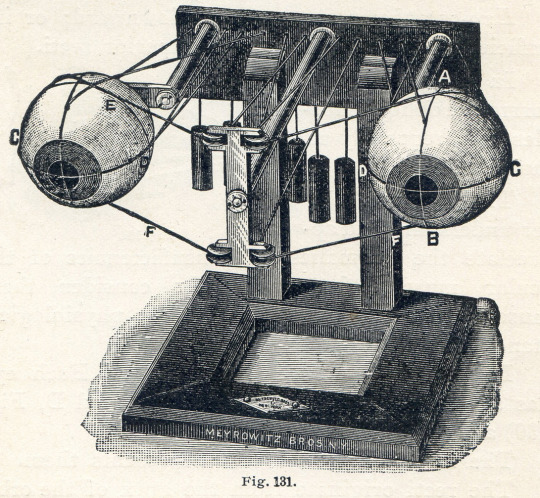
Quit yer eyeballin’ me, boy!
#scientific instruments#vintage illustration#illustration#scientific illustration#funny#humor#humour
27 notes
·
View notes
Text
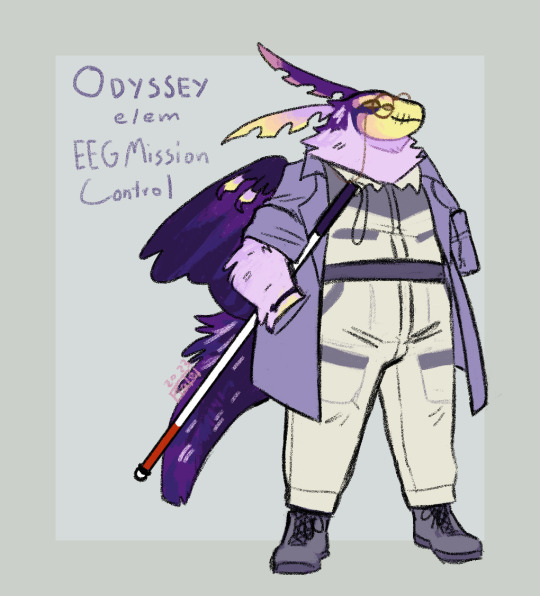
i cant post Tune without also posting Odyssey. do not separate.
Odyssey is an engineer, formerly the director of Mission Control, and before even that e did field work. Now, e’s supposedly retired from all duties, but Odyssey refuses to leave. E wont let the new owners run the team into the ground. (and e’s still holding onto some distant hope of finding es best friend alive, or at least closure)
-> Originally Odyssey was a field researcher alongside es queerplatonic partner Tune in their 20s, until the risks of such work became apparent. E then went on to develop systems to communicate with and coordinate the research team and monitor the Otherworld from safely on the ‘reality’ side of the portal. E established Mission Control, and led it for decades.
-> Tune and Odyssey were very close for a very long time, having met in their school years. They were best friends, partners for life, two halves of a whole. It’s been some years now since Tune’s disappearance, and Odyssey’s mostly come to terms with it, but still feels his absence keenly.
-> Odyssey’s a generally kind individual but not particularly nice. E’s gruff, immensely stubborn, with a mean sarcastic streak. Some coworkers might describe em as cantankerous. But at the end of the day e’s well-intentioned and altruistic.
-> Odyssey is very, VERY bitter about the investors who bought ownership of the team from the original founders a couple years back. E hates them. E’s just WAITING for the chance to prove there’s something unscrupulous happening, e can FEEL it. E hasn’t had results yet but the vibes are rancid.
-> Though formally retired, Odyssey continues to do much of the same work e’s been doing for decades, out of spite and because e trusts few people with the systems e built. E adamantly refuses to cooperate with anyone associated with the company, which is probably directly related to es early ‘retirement’. Odyssey’s not happy about it and won’t do them any favours.
-> Odyssey is only middle aged but e feels so much older. E’s so tired. And so worried. E hopes for the best but is always prepared for the worst.
-> Odyssey’s role as director was succeeded by Maven, who e mentored. Odyssey treats them as a ward and as a friend. E respects and trusts them, but…… When the Storm hit, it was one of Maven’s first missions directing with little input from Odyssey. It was supposed to be that, anyway, before that disaster. Odyssey doesn’t blame them for what happened, but but can’t seem to talk them out of beating themself up over it. Directing the EEG is no longer Odyssey’s job so e tries to step back and let Maven make their own decisions, but they’ve obviously not dealt well with the pressure, and Odyssey can’t leave well enough alone. E has a tendency to step in and take over es old duties at the first sign of trouble in a misguided attempt to shield Maven from the trauma of handling another crisis. E doesn’t mean to imply that they’re not capable, but unfortunately they are not helping Maven’s shattered confidence and fear of making mistakes by taking control from them.
-> Odyssey is legally blind, and though es glasses can help em make out some shapes in the right conditions, in unfamiliar spaces and bad lighting e utilizes a cane to get a feel for es surroundings. While es poor eyesight is likely hereditary, e became an amputee following a severe injury on es last field mission. E opts not to use any prosthetics, finding them uncomfortable and unwieldy. E’s often accompanied by one or both of the spider shaped robots e designed and programmed to assist the exploration team, which have been retired from the field as well since suffering some damage in the Storm. Odyssey is very fond of them.
-> The larger robot, Marie, was named after Odyssey’s cousin Mariner, who also worked for the EEG for a time. The two used to be close, but have had a falling out coinciding with Tune’s presumed death and Mariner’s retirement. Xe pushed for Odyssey to quit as well, but despite xer desperation xe wouldn’t confess why xe was so adamant about it.
-> The loss of Tune hit Odyssey very hard, and e’s become quite reclusive. E tends to stick to es room when not doing other work, and would spend a lot of time alone if not sought out by the other people who are close with em.
-> Spirit, Tune’s sibling, can probably best understand what Odyssey’s going though. The two have always gotten along well, having met through Tune. When Odyssey was injured, they requested Spirit join the team in es place, providing a glowing recommendation to the then owners. E’s always thought highly of Spirit, as a skilled and reliable member of the team (and someone e could trust to keep an eye on Tune where e couldn’t).
-> Spirit’s been different, recently. Odyssey has slowly tried opening up to them to talk about their shared loss, after es initial attempts to distance emself from the team in es grief. But any attempt seems stilted and awkward, so usually Odyssey never gets around to that part, and sticks to shallow small talk and talking At them about other problems. Honestly e just wants their company, and e feels they could use it, too. Odyssey worries for Spirit’s physical wellbeing in the Otherworld, and their mental wellbeing in the wake of losing their sibling. But they’re still capable of looking after themself, so e doesn’t push too hard. E just figures… well. Spirit probably needs the same kind of help e does, and e’s trying to be that for them.
-> If there’s a coworker that Odyssey really Does Not get along with, it’s Curiosity. In the past they’ve had a standard and respectful relationship. But with Tune M.I.A. and the EEG’s new ownership, Odyssey’s being phased out of the team though circumstance and es own actions and e’s feeling quite frustrated. E projects a lot of those frustrations into Curiosity, the new de facto leader of the field team and symbolic of the changes Odyssey rejects. Curiosity, for her part, isn’t keen on sitting around and taking flak from Odyssey.
-> Mostly they try to avoid each other, and that turns out fine. But when they do interact, Odyssey is… difficult about it. E will nitpick any plan of hers to test how it holds up, always double-checks her work, tries to pull rank/seniority regardless of relevance.. all in all, nothing malicious, but instead unreasonably hypercritical. E claims e’s only making sure she’s up to handle whatever the Otherworld throws at them next.
-> Phoenix on the other hand is a long time friend of Odyssey and Tune, having also met them through school before he dropped out. They’ve been a sturdy pillar of support for Odyssey through es grief, and regularly checks up on em to make sure es looking after emself. Though Phoenix, like Curiosity, is ambivalent about the new ownership, he is unlike Curiosity in that he is in good standing with Odyssey and is privy to sooo many rants about it. They talk often. Phoenix is really the only other person Odyssey trusts with maintaining the systems e built.
-> Phoenix and Odyssey had a brief romantic fling as young adults, which Odyssey now finds very amusing. Even moreso because Phoenix is kind of embarrassed about being ‘something of a headstrong dumbass’ at that age, in their own words. It’s one of the few things Odyssey and Curiosity (who also once dated Phoenix) can agree upon. It’s all in good fun.
#image#alt text#my art#my characters#set: eeg#char: odyssey#flight rising#flight rising art#odyssey is maybe my favourite :]#i think e’s neat#named after the 2001 mars odyssey orbiter#which is/was the primary means of communication between nasa and surface probes on mars#with rovers such as spirit and opportunity and curiosity. and the phoenix lander#the names for es spider robots Themis and Marie come from names for scientific instruments onboard the satellite#Themis: THermal EMission Imaging System#Marie: MArs Radiation Envronment Experiment (ok i don’t know where they took the i from or which word is the e)#anyway i love space probes
58 notes
·
View notes
Text
The ADHD urge for a sonic screwdriver is SO REAL
#doctor who#sonic screwdriver#dr who#they are scientific instruments!#wibbly wobbly timey wimey#literally pointing and thinking#would eliminate all my problems#sonic screwdrivers are cool#adhd things#adhd stuff#maybe Clara’s right she said I have the AD stuff
54 notes
·
View notes
Text
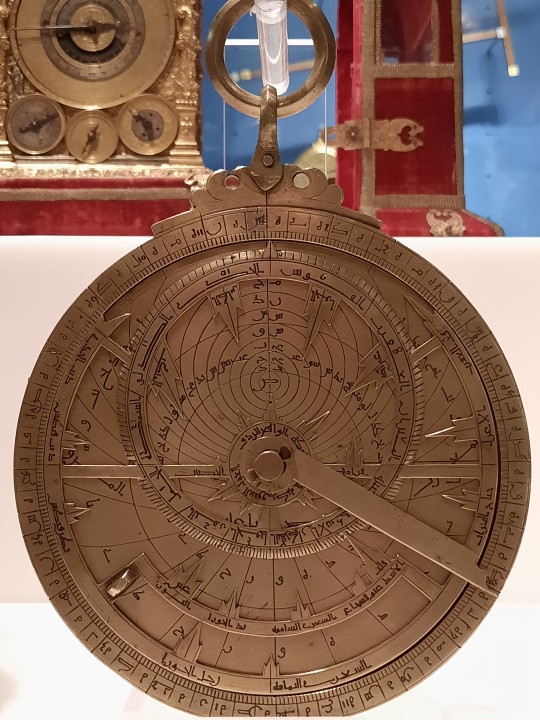
Astrolabe, Arabic, 10th C.
On display in the Museo Galileo, Florence
#scientific instruments#astrolabe#history of science#Museo Galileo#Florence#photography#personal collection
9 notes
·
View notes
Text

Ludovica Bonnaire the woman that you are oghh. My god.
#generate random art#h. hey girl can I. can I follow you around a carry your scientific instruments for you. can I get you coffee.#please I would be such a good pa please please please please#ludovica bonnaire#tiger tiger
4 notes
·
View notes
Text
Semi-automatic Bio-chemistry Analyzer
Semi-automatic Bio-chemistry Analyzer also known as chemistry analyzer is a compact, semi-automated and high performance analyzer comprises 8 assay modes offers photometric range from 0 to +3.0 OD with 3 level temperature range along with temperature accuracy of ±0.1˚C. Incorporated with excellent QC function with large memory. Equipped with different wavelengths such as 340 nm, 405 nm, 492 nm, 510 nm, 546 nm, 578 nm, 620 nm with accuracy of ±2nm. Built-in thermal printer with Real time graph display.
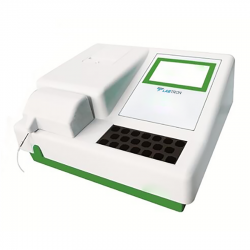
0 notes
Text
-25°C Chest Freezer
Cabinet type=chest; Capacity=358-l; Temperature Range=10-to-25-deg-c; Ambient Temperature=16-to-32-deg-c; Cooling Performance=25-deg-c; Shop online at Labtron.cc.

0 notes
Text
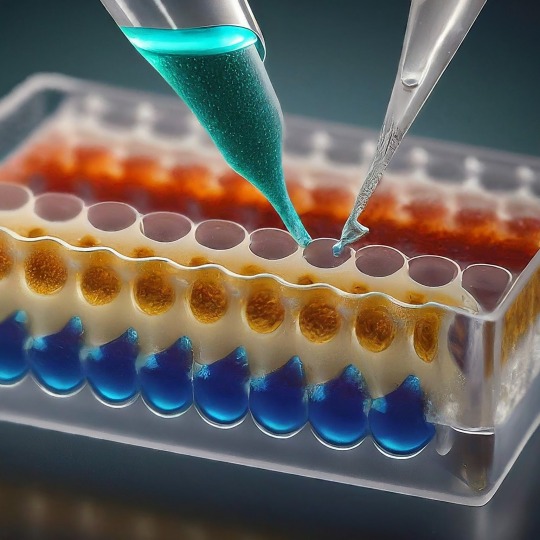
ELISA: A Powerful Tool for Detecting the Invisible
ELISA, or Enzyme-Linked Immunosorbent Assay, has become a cornerstone of medical diagnostics and biological research. This versatile technique allows scientists to detect and quantify minute amounts of target molecules, such as proteins, antibodies, and even viruses, with remarkable accuracy. In this blog, we'll delve into the world of ELISA, exploring its various types, its applications, and the exciting future directions this technology holds.
At its core, ELISA relies on the exquisite specificity of antibodies. Antibodies are highly specialized proteins produced by the immune system in response to foreign invaders. Each antibody can bind to a unique structure, called an antigen, on a specific molecule. In an ELISA, scientists leverage this binding property to create a sensitive detection system.
The 1960s witnessed a surge in interest in immunoassays, techniques that utilize the specificity of antibodies to detect target molecules. One such technique, radioimmunoassay (RIA), developed by Rosalyn Yalow and Solomon Berson, revolutionized medical diagnostics. RIA used radioactively labeled antibodies to detect antigens, offering high sensitivity. However, concerns regarding the safety of radioactive materials fueled the search for a safer alternative. The year 1971 marked a turning point. Independently, Eva Engvall and Peter Perlmann published their work on a novel technique – the enzyme-linked immunosorbent assay (ELISA). ELISA replaced radioactive labels with enzymes, eliminating the safety concerns associated with RIA. Like RIA, ELISA harnessed the specific binding between antibodies and antigens. However, it employed enzymes that could generate a detectable signal, such as a color change, upon interacting with a substrate. This innovation paved the way for a safer and more user-friendly diagnostic tool.
The basic ELISA protocol involves immobilizing the target antigen on a solid surface like a plate well. Then, a sample containing the molecule of interest (e.g., a suspected virus) is introduced. If the target molecule is present, it will bind to the immobilized antigen. Next, an antibody specific to the target molecule, linked to an enzyme, is introduced. This "detection antibody" binds to the target molecule already attached to the antigen. Finally, a substrate specific to the enzyme is added. This antigen-antibody binding is visualized using an enzyme linked to a reporter molecule. When the enzyme encounters its substrate, a detectable signal is produced, such as a color change or luminescence. The intensity of this signal is directly proportional to the amount of antigen present in the sample, allowing for quantification. The beauty of ELISA lies in its adaptability. Several variations exist, each tailored for specific detection needs.
The Four Main ELISA Formats are:
Direct ELISA: Simplicity at its finest. In this format, the antigen is directly coated onto the ELISA plate. A labeled antibody specific to the antigen is then introduced, binding directly to its target. After washing away unbound molecules, the enzyme linked to the antibody generates a signal upon addition of the substrate. Direct ELISA offers a rapid and straightforward approach, but sensitivity can be lower compared to other formats due to the lack of amplification.
Indirect ELISA: Unveiling the Power of Amplification. Similar to the direct ELISA, the antigen is first coated onto the plate. However, instead of a labeled primary antibody, an unlabeled one specific to the antigen is used. This is followed by the introduction of a labeled secondary antibody that recognizes the species (e.g., mouse, rabbit) of the primary antibody. This two-step approach acts as an amplification strategy, significantly enhancing the signal compared to the direct ELISA. However, the presence of an extra incubation step and the potential for cross-reactivity with the secondary antibody add complexity.
Sandwich ELISA: Capturing the Antigen Between Two Antibodies. Here, the capture antibody, specific for one region of the antigen, is pre-coated onto the ELISA plate. The sample containing the antigen is then introduced, allowing it to be "sandwiched" between the capture antibody and a detection antibody specific for a different region of the same antigen. A labeled secondary antibody or a labeled detection antibody itself can then be used to generate the signal. Sandwich ELISA boasts high sensitivity due to the double-antibody recognition and is often the preferred format for quantifying analytes.
Competitive ELISA: A Race for Binding Sites. In this format, the antigen competes with a labeled antigen (usually a known amount) for binding sites on a capture antibody pre-coated onto the plate. The more antigen present in the sample, the less labeled antigen can bind to the capture antibody. Following a washing step, the amount of bound labeled antigen is measured, providing an inverse relationship between the signal and the concentration of antigen in the sample. Competitive ELISA is particularly useful for studying small molecules that may be difficult to directly conjugate to an enzyme.
ELISA's Reach: From Diagnostics to Research. The applications of ELISA are as vast as they are impressive. Let's delve into some key areas where ELISA plays a vital role:
Unveiling the Mysteries of Disease: Diagnostics: ELISA is a cornerstone of diagnosing infectious diseases like HIV, Hepatitis, and Lyme disease. It detects antibodies produced by the body in response to the invading pathogen, providing valuable information for early detection and treatment. Monitoring Autoimmune Diseases: ELISA helps monitor autoimmune diseases like rheumatoid arthritis and lupus by measuring specific antibodies associated with these conditions. Cancer Screening: Certain cancers can be detected by identifying tumor markers, proteins elevated in the blood of cancer patients. ELISA assays are being developed to detect these markers for early cancer screening.
Safeguarding Food Quality: Allergen Detection: Food allergies can be life-threatening. ELISA ensures food safety by enabling the detection of allergens like peanuts, gluten, and milk in food products, protecting consumers with allergies. Monitoring Foodborne Pathogens: ELISA can identify harmful bacteria, viruses, and toxins in food, preventing outbreaks of foodborne illnesses.
Environmental Monitoring: Pollutant Detection: ELISA can detect pollutants like pesticides and herbicides in water and soil samples, contributing to environmental protection efforts. Microbial Analysis: This technique can be used to identify and quantify specific microbes in environmental samples, providing insights into ecosystem health.
Research and Development: ELISA plays a crucial role in various research fields: Drug Discovery: It helps researchers assess the effectiveness of new drugs by measuring drug-target interactions and monitoring drug levels in the body. Vaccine Development: ELISA is instrumental in developing vaccines by evaluating immune responses to vaccine candidates. Basic Research: Scientists use ELISA to study various biological processes by detecting and quantifying specific molecules involved in these processes.
Despite its established role, ELISA is evolving alongside technological advancements. New multiplex platforms allow for the simultaneous detection of various targets in a single sample, boosting efficiency in biomarker discovery and disease analysis. Automation streamlines workflows minimizes errors, and increases throughput, making high-throughput screening feasible in drug development and clinical settings. Miniaturization and portable devices enable rapid on-site diagnostics, providing healthcare professionals with real-time data for quicker interventions. Additionally, ongoing research is improving assay sensitivity, reducing background noise, and expanding detection limits, allowing for the identification of trace analytes and early disease biomarkers with greater accuracy than ever before. Integration of ELISA with emerging technologies such as microfluidics, nanotechnology, and artificial intelligence holds promise for enhancing assay performance, scalability, and data analysis capabilities.
These advancements hold promise for even wider applications of ELISA in the future. ELISA has revolutionized our ability to detect and quantify biological molecules. Its versatility, accuracy, and adaptability make it an invaluable tool across various scientific disciplines. As research continues to refine and innovate ELISA techniques, we can expect even more exciting possibilities to emerge in the years to come. ELISA's future is bright, promising to play a pivotal role in unraveling the mysteries of the biological world and improving human health.
#science sculpt#life science#molecular biology#science#biology#artists on tumblr#ELISA#immunology#immunotherapy#diagnostic management software#diagnosticimaging#history of immunology#scientific advancements#biotechnology#scientific research#scientific equipment#scientific instruments#techniques in biotechnology#scientific illustration#lab equipment#sciencenature#laboratory#lab skills#molecular diagnostics market
10 notes
·
View notes